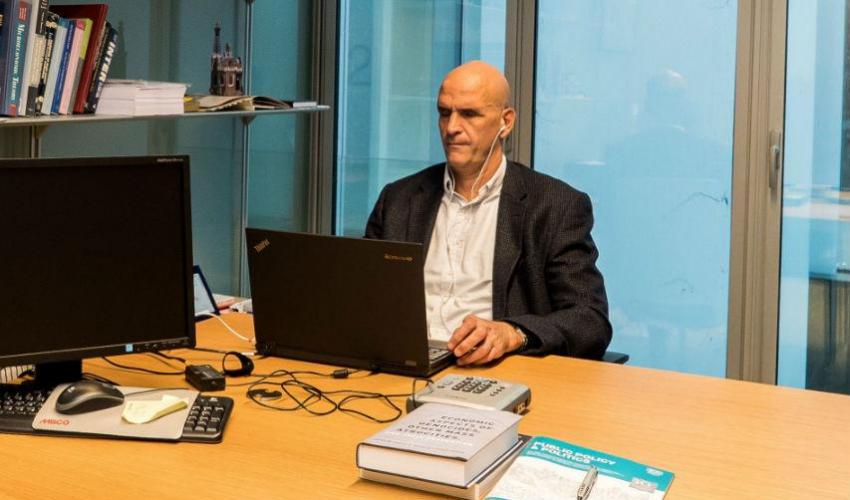
Understanding Wars through Economics
MASSIMO MORELLI STUDIES CONFLICT RISK ANALYZING, AMONG OTHER THINGS, POLITICIANS' COST BENEFIT RATIO AND THE GEOGRAPHICAL CONCENTRATION OF RESOURCESPolicy makers, intelligence agencies, companies and investors look for the same valuable information: where will the next war zone be? The rationalist explanations for war advanced in literature started looking for an answer in the mid 90s. It’s been ten years since Massimo Morelli, Professor of Political Science at the Bocconi University, began dealing with the matter. He has gradually enhanced his models to estimate conflict risk. In order to provide better explanations, he has taken political bias, strategy militarization, mediation, and resource concentration into account.
Hawks and doves
Morelli made his first approach to the Economics of Conflicts and inter-state wars with a theoretical study on political bias. The incentive to go to war depends on the decision maker’s cost/benefit ratio compared to that of the whole country. “It is the formal demonstration of the so-called democratic peace”, Morelli says, “that is the idea that two unbiased democracies are less likely to go to war with each other”. The selection of leaders willing to enter conflicts is explained by the fact that threats are most credible when delivered by “hawks”. The relationship with leaders is the focus of a paper on corruption and extremism in civil wars by Morelli and Antonio Nicolò (universities of Padua and Manchester). According to the research, which is still under way, in the event of a war between two ethnic groups, the presence in the recent past of a corrupt ruling class produces the selection of radical and highly ideological leaders, who are assumed to be less corruptible by the enemy.
Militarization and mediation
Most explanations for war take the military power of the players involved in the dispute as given. To overcome this idea, in 2009 Morelli introduced the variable of militarization, showing the flaws in models that identify only two kind of strategies in international relations: hawks and doves. “A third strategy arises when the level of militarization is incorporated as an endogenous variable: deterrent. War occurs as a result of a mix of different armament choices, namely dove, hawk, and deterrent, and mediation processes such as those promoted by the United Nations”. When conflicts arise because of the asymmetric information between disputants, mediators can be more effective than arbitrators who enforce settlements. Mediation reduces both the likelihood of war for any given level of militarization and the incentives to militarize. “There is no need for the UN to strengthen its military role. Mediators are more effective. They make the enforcement power redundant as long as they are perceived as unbiased. This is why Scandinavian negotiators are more successful than American ones”.
Resource concentration
Morelli’s next move was the inclusion of geography and resources in his models. Natural riches such as oil and gas have triggered inter-state wars since World War II. Conflict is more likely when just one country has natural resources close to the border or when both countries have natural resources, but the latter are located asymmetrically along the border. Another paper highlights the importance of natural resource concentration in civil wars and introduces a new measure: the Oil Gini. If the Gini coefficient is a measure of inequality, the Oil Gini measures oil and gas concentration. “War is more likely in places where resource and group concentration are high”.
From mass killings to mass displacements
The line of study on geography and resource concentration has led to an additional field of inquiry: genocides. Large amounts of natural resource rents, constraints regarding rent sharing, and low productivity of labor explain the 50 episodes of mass killings registered since the end of World War II. The next step taken by Morelli is researching a consequence of wars and mass killings: mass displacements that add up to economic and climate migrations. “Mass killings and mass displacements have a complementary relationship”. Power relations is another research stream connected to the above-mentioned lines of study. Morelli has recently obtained an Erc Advanced Grant thanks to his proposal. “We already have the first results. Traditionally, inequality is the variable that explains the onset of civil wars. We are showing that it disappears when a much more powerful engine of conflict is evaluated: the asymmetry of military capabilities and economic strength”.
Find out more
Political Bias and War, Matthew O. Jackson, Massimo Morelli, American Economic Review, 2007
Strategic Militarization, Deterrence and Wars, Matthew O. Jackson, Massimo Morelli, Quarterly Journal of Political Science, 2007
Mediation and Peace, Johannes Hörner, Massimo Morelli, Francesco Squintani, Review of Economic Studies, 2012
Dispute Resolution Institutions and Strategic Militarization, Adam Meirowitz, Massimo Morelli, Kristopher W. Ramsay, Francesco Squintani, working paper
The Geography of Interstate Resource Wars, Francesco Caselli, Massimo Morelli, Dominic Rohner, Quarterly Journals of Economics, 2015
Resource Concentration and Civil Wars, Massimo Morelli, Dominic Rohner, Journal of Development Economics, 2015
Strategic Mass Killings, Joan Esteban, Massimo Morelli, Dominic Rohner, Journal of Political Economy, 2015
by Claudio Todesco
